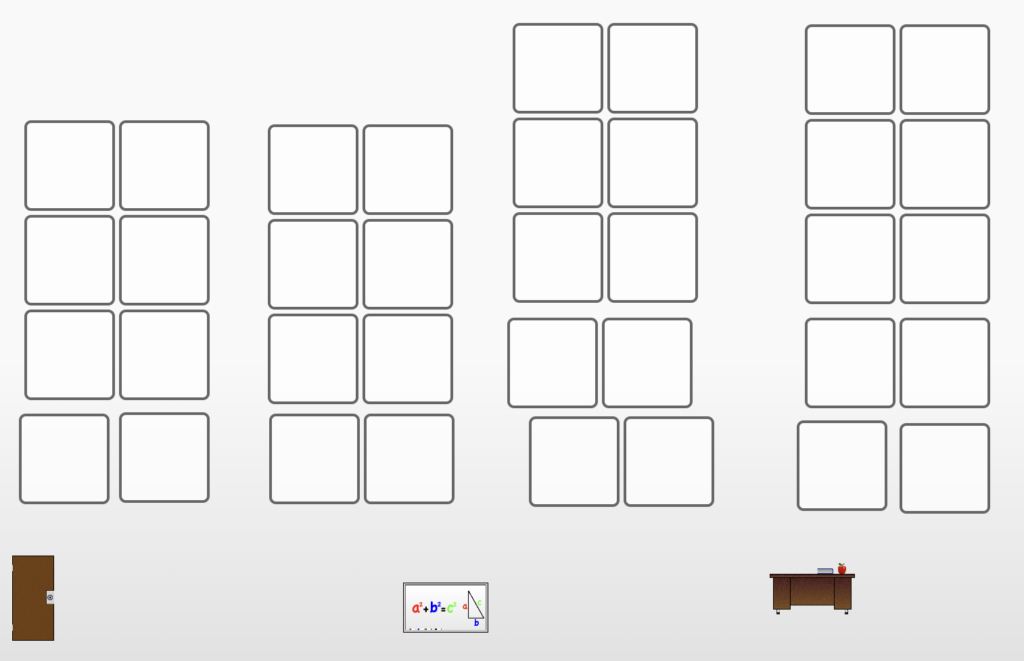Engagement isn’t something you can infer from smiling faces or a classroom arrangement. Engagement is what the brain attends to.
Source: Teacher-blogger Blake Harvard
Should students sit in rows?
In my view, there are only two silly answers to this question:
- No, never.
- Yes, always.
The answer, as all sensible folks know, is more nuanced: it depends.
In my room, students sit in pairs, and those pairs are situated in columns and rows. This is what my Powerschool seating chart looks like.

I used to have students sit in groups of four, facing each other in pods. I found this sub-optimal, mainly because too many of my students were needing to exert too much effort too much of the time to focus on something besides the folks they were sitting at the table with. E.g., when they were doing things like this —
- Writing
- Reading
- Having a pair talk
- Listening to direct instruction or another student
— they were needing to put cognitive effort into not being distracted by the faces sitting across from them.
So, for my class, I find that the most learning-conducive environment is the one organized like you see in the seating chart above.
Anti-row folks would say that in such a room, students are being treated like industrial widgets. Community cannot be fostered in such a room. Such a seating format is militaristic or prison-like. In this kind of a place, it's all about the teacher, the sage on the stage.
There was a brief time in my career where I even bought in to this kind of thinking.
But then I started noticing row-seating classrooms run by competent colleagues in which the classroom vibe was
- Highly engaging,
- Warmly communal, and
- Deeply humanizing.
In fact, they were much more so than my own group-seating room was. And I started to realize that it was because I was placing such a tax on my students' effort levels by seating them in a way that wasn't best for the kind of learning work we most often do in my class (i.e., writing, reading, speaking and listening, knowledge-building, arguing — see my book).
In other words, it turned out that the seating chart wasn't the deal-maker or the deal-breaker. As comforting as either-or thinking can be with its black-and-white certainties, pedagogical decisions often resists dogmatic oversimplification.
And so in my room with rows, I find that:
- My students have less to tune out when trying to work independently.
- They can be comfortable when I am giving direct instruction at the front of the room, not needing to crane their necks.
- They can be comfortable when we're doing something on the document camera or the projector screen.
- They can still interact with one another every single day (e.g., through Think-Pair-Share, Conversation Challenge, and Pop-up Debate).
So, should your students sit in rows? My answer is that it depends on what kind of work they're most often going to be doing.
But in my room, yes: students should.
Best,
DSJR
Stephanie Roederer says
BLESS. Thank you so much for saying this!! I have struggled with this for years, that students think if they’re seated facing each other, it signals to their bodies that they should be talking to each other. That’s why if I need their focus to be on me, I have to seat them all facing forward, then when it’s time to chat they can turn or move to different seats.
Dave Stuart Jr. says
Stephanie, give my warm regards to the grew there in Louisville
Kris Totzke says
THANK YOU FOR THIS CLARIFICATION! I’ve never been able to develop a good argument as to why I need to move my classroom from groups back to pairs in rows. Craning the neck is horrible! Trying not to focus on the kid across from you is horrible – just another good excuse to hide in their phone! But then Kagan Structures tell me I’m a loser if I don’t put my kids in groups! I’m reformatting the seating chart this weekend to switch things up for the second half of the trimester. If I remember to, I’ll report back about my experiment!
Dave Stuart Jr. says
Kris, you and I both know Kagan Structures ain’t got nothing on you.
Tell the New Buffalo fam I said hello
Jennifer Fletcher says
This really got me thinking. As someone who needs quiet and alone time to learn, I appreciate the connection between seating arrangements and cognitive load. If I spend a lot of time in face-to-face conversations with folks, I need a nap afterward to wash the extra buzz out of my brain. Thank you for a thoughtful post!
Dave Stuart Jr. says
Jennifer, I’m so glad to hear from you. Thank you, it was my pleasure.
Mark Ellis says
Totally agree. And if you need groups of 4 for something, where you do want them facing each other and talking, alternating rows can turn around and magically there is a group of 4 to work and talk together.